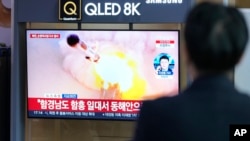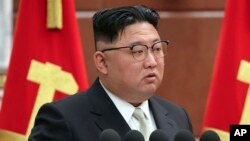North Korea tested a new underwater nuclear attack drone designed to create a "radioactive tsunami" on enemy coasts, state media claimed Friday, unveiling a weapon that appears to share some features with Russia's Poseidon super torpedo.
The test of the previously unknown North Korean drone, dubbed "Haeil," came during three days of military drills guided by the country's leader, Kim Jong Un, according to the state-run Korean Central News Agency (KCNA).
The mission of the drone is to "stealthily infiltrate into operational waters and make a super-scale radioactive tsunami through underwater explosion to destroy naval striker groups and major operational ports of the enemy," KCNA said.
The drone was launched Tuesday off the coast of North Korea's Riwon County and stayed in the water for more than 59 hours, doing oval and figure-eight patterns, before detonating its dummy warhead near a "mock enemy port" in Hongwon Bay, KCNA reported.
The drone "can be deployed at any coast and port or towed by a surface ship," it added.
Since 2019, North Korea has frequently unveiled new weapons systems, many of which it says are nuclear-capable. It is not clear whether North Korea has succeeded in building warheads small enough to mount on missiles.
Pyongyang claims its latest tests are a response to U.S.-South Korea military exercises, which have increased in response to North Korea's unprecedented number of missile launches and other threats.
Defense analysts say North Korea's latest weapon appears to be an attempt to replicate Russia's nuclear-armed Poseidon, a new category of nuclear weapons that is essentially a cross between a large torpedo and an underwater drone.
Russia earlier this year claimed to have built its first batch of Poseidons, but it is not clear whether the advanced weapon has been deployed.
If North Korea has indeed built its own underwater nuclear weapon, there would be important differences between the Russian and North Korean versions, analysts say.
Russia's Poseidon uses nuclear propulsion – giving it essentially unlimited range. And Moscow says it can be launched from a submarine, making it much harder for adversaries to detect.
North Korea does not possess naval nuclear propulsion and is believed to have only one ballistic missile submarine, an experimental vessel, which would not be capable of handling such a weapon.
The North Korean weapon unveiled Friday would be "highly vulnerable" to the anti-submarine warfare capabilities of the United States and its allies, said Ankit Panda, a senior fellow in the Nuclear Policy Program at the Carnegie Endowment for International Peace in Washington.
However, North Korea would not need the endurance that comes with nuclear propulsion if the goal is to be able to reach the southern South Korean city of Busan or other nearby coastal targets, Panda said.
State media posted several images of the test, but the weapon was not fully visible in any of the photos. In one of the pictures, Kim smiled adoringly at one of the yellow and white weapons, which was partially obscured.
North Korean state media have in the past exaggerated the country's defense capabilities.
Leif-Eric Easley, a professor at Ewha University in Seoul, said North Korea's claims about a nuclear-capable underwater drone should be met with skepticism.
"But it is clearly intended to show that the Kim regime has so many different means of nuclear attack that any preemptive or decapitation strike against it would fail disastrously," he said.
Kim Dong-yub, a professor at Seoul's University of North Korean Studies, said it was difficult to immediately rule out the possibility of North Korea developing such a weapon.
"I don't know the exact extent to which we should believe North Korea's claims, but unmanned, underwater weapons systems have already been developed in various forms around the world," he said.
In its report Friday, KCNA said North Korea also launched four "strategic cruise missiles" as part of its three-day military drills this week.
The cruise missiles were tipped with mock nuclear warheads, which exploded in the air, 600 meters above their target, KCNA added.
It appears to be North Korea's latest attempt to simulate a nuclear airburst, the detonation of a warhead above ground to increase its effectiveness.
Earlier this week, North Korean state media conducted another airburst simulation – the first time Pyongyang has ever mentioned such a maneuver.
In the Friday report, Kim, the North Korean leader, hinted at continued weapons tests, as part of a response to what he called the "reckless military provocations" of the United States and South Korea.
Washington and Seoul on Thursday wrapped up 11 days of major military exercises, including some of their largest field exercises in five years.
However, the two allies are set to continue their displays of military might, as a U.S. nuclear-powered aircraft carrier is expected to visit South Korea in the coming days.










